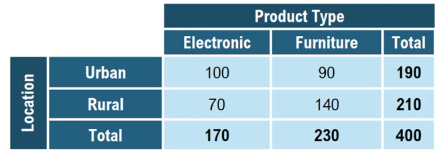Table of contents
- 1. Introduction to Statistics53m
- 2. Describing Data with Tables and Graphs2h 1m
- 3. Describing Data Numerically1h 48m
- 4. Probability2h 26m
- 5. Binomial Distribution & Discrete Random Variables2h 55m
- 6. Normal Distribution & Continuous Random Variables1h 48m
- 7. Sampling Distributions & Confidence Intervals: Mean1h 17m
- 8. Sampling Distributions & Confidence Intervals: Proportion1h 20m
- 9. Hypothesis Testing for One Sample1h 8m
- 10. Hypothesis Testing for Two Samples2h 8m
- 11. Correlation48m
- 12. Regression1h 4m
- 13. Chi-Square Tests & Goodness of Fit1h 30m
- 14. ANOVA1h 4m
13. Chi-Square Tests & Goodness of Fit
Contingency Tables
Struggling with Statistics for Business?
Join thousands of students who trust us to help them ace their exams!Watch the first videoMultiple Choice
A company wants to understand if the type of product (Electronic vs. Furniture) purchased is associated with the customer's location (Urban vs. Rural). A survey was conducted, and the following data was collected from 400 customers. Calculate the expected frequencies for each cell in the table, assuming the null hypothesis that the type of product purchased and the location of the customer are independent.

A
E1,1 = 100; E2,1 = 100; E1,2 = 100; E2,2 = 1000
B
E1,1 = 42.5; E2,1 = 57.5; E1,2 = 47.5; E2,2 = 52.5
C
E1,1 = 80.75; E2,1 = 89.25; E1,2 = 109.25; E2,2 = 120.75
D
E1,1 = 100; E2,1 =70; E1,2 = 90; E2,2 = 140
 Verified step by step guidance
Verified step by step guidance1
Step 1: Understand the problem. The goal is to calculate the expected frequencies for each cell in the table under the assumption that the type of product purchased and the customer's location are independent. This involves using the formula for expected frequency: E(i,j) = (Row Total * Column Total) / Grand Total.
Step 2: Identify the totals from the table. The row totals are Urban = 190 and Rural = 210. The column totals are Electronic = 170 and Furniture = 230. The grand total is 400.
Step 3: Calculate the expected frequency for the cell (Urban, Electronic). Use the formula: E(Urban, Electronic) = (Row Total for Urban * Column Total for Electronic) / Grand Total. Substituting the values: E(Urban, Electronic) = (190 * 170) / 400.
Step 4: Calculate the expected frequency for the cell (Urban, Furniture). Use the formula: E(Urban, Furniture) = (Row Total for Urban * Column Total for Furniture) / Grand Total. Substituting the values: E(Urban, Furniture) = (190 * 230) / 400.
Step 5: Repeat the process for the Rural row. Calculate E(Rural, Electronic) = (Row Total for Rural * Column Total for Electronic) / Grand Total, and E(Rural, Furniture) = (Row Total for Rural * Column Total for Furniture) / Grand Total.

 8:18m
8:18mWatch next
Master Contingency Tables & Expected Frequencies with a bite sized video explanation from Patrick
Start learningRelated Videos

